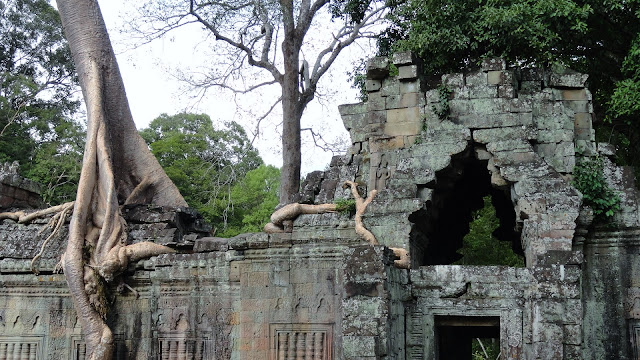After some R&R at the hotel, Sopheap picked us up and we drove to Preah Khan. Preah Khan was located just North of Angkor Thom and was yet another temple built in the 12th century for King Jayavarman VII.
The ruins of the site have provided evidence that Preah Khan functioned as a city, temple and Buddhist university. It was a significant community with almost 100,000 officials and servants and appeared to be quite wealthy. There is a moat surrounding the compound and each causeway features devas and asuras carrying a naga (similar to what we saw at Angkor Thom). Historians believe that this is an indication that Preah Khan was more significant to the King than Ta Prohm and the other temples that did not have this feature.
The ruins of the site have provided evidence that Preah Khan functioned as a city, temple and Buddhist university. It was a significant community with almost 100,000 officials and servants and appeared to be quite wealthy. There is a moat surrounding the compound and each causeway features devas and asuras carrying a naga (similar to what we saw at Angkor Thom). Historians believe that this is an indication that Preah Khan was more significant to the King than Ta Prohm and the other temples that did not have this feature.
Devas on the left side of the causeway.
A close-up of the head of the naga.
And the asuras side of the causeway. Sopheap said that most of the missing deva and asuras heads had been taken by looters.
I caught Christopher taking a selfie.
The statue below was similar (with the four faces) to those we saw at The Bayon the day before.
The outer wall of the compound featured several large garudas (a mythical bird or bird-like creature in Hindu and Buddhist mythology). Each garuda held the tail of a naga in its left hand and placed its right foot on the serpent's head.
Under King Jayavarman VII, all of the temples that were built in his honor were Buddhist and featured Buddhist narrative artwork. After his death, all of the Buddhist images in his temples were destroyed in an anti-Buddhist movement by followers of the new Hindu King, Jayavarman VIII. There were several areas around the compound where we could see the niches that formerly contained Buddhist images.
In the photo below, each "scallop" on top of the wall held a Buddha image which had been removed after King Jayavarman VII died. Sopheap said, at this temple alone, there were over 1,600 Buddha images that were destroyed.
In some areas (photo below), the Buddhist images were replaced with Hindu images.
Inside the compound.
A lot of these sites were looted and vandalized during the conflict with the Khmer Rouge. Sopheap told us that some of the free-standing statues at Preah Khan have been removed for safe-keeping. In fact, he said that a statue from this site, similar to the ones in the photos below, was offered at a Sotheby's auction. I don't know if that is true or not - I can't imagine how a statue of this considerable size and weight could be smuggled out of the compound and the area without calling a lot of attention to the effort.
A pair of nagas over a small moat inside the compound.
Similar to Ta Prohm, Preah Khan has been left largely un-restored, with numerous trees and other vegetation growing among the ruins.
The tree in the photo below died but its roots were left embedded in the temple.
There were actually three temples on our itinerary for the afternoon but it was hot and the kids (and maybe Kevin and I, too) were getting a little bored with visiting the temples so we shortened the itinerary and finished our tour here. We wanted to do a little shopping at the night markets and walk around Siem Reap before dinner so we asked Sopheap to take us back to the hotel.
Have a great Monday!



















































No comments:
Post a Comment